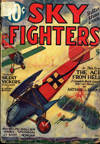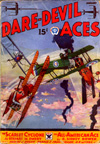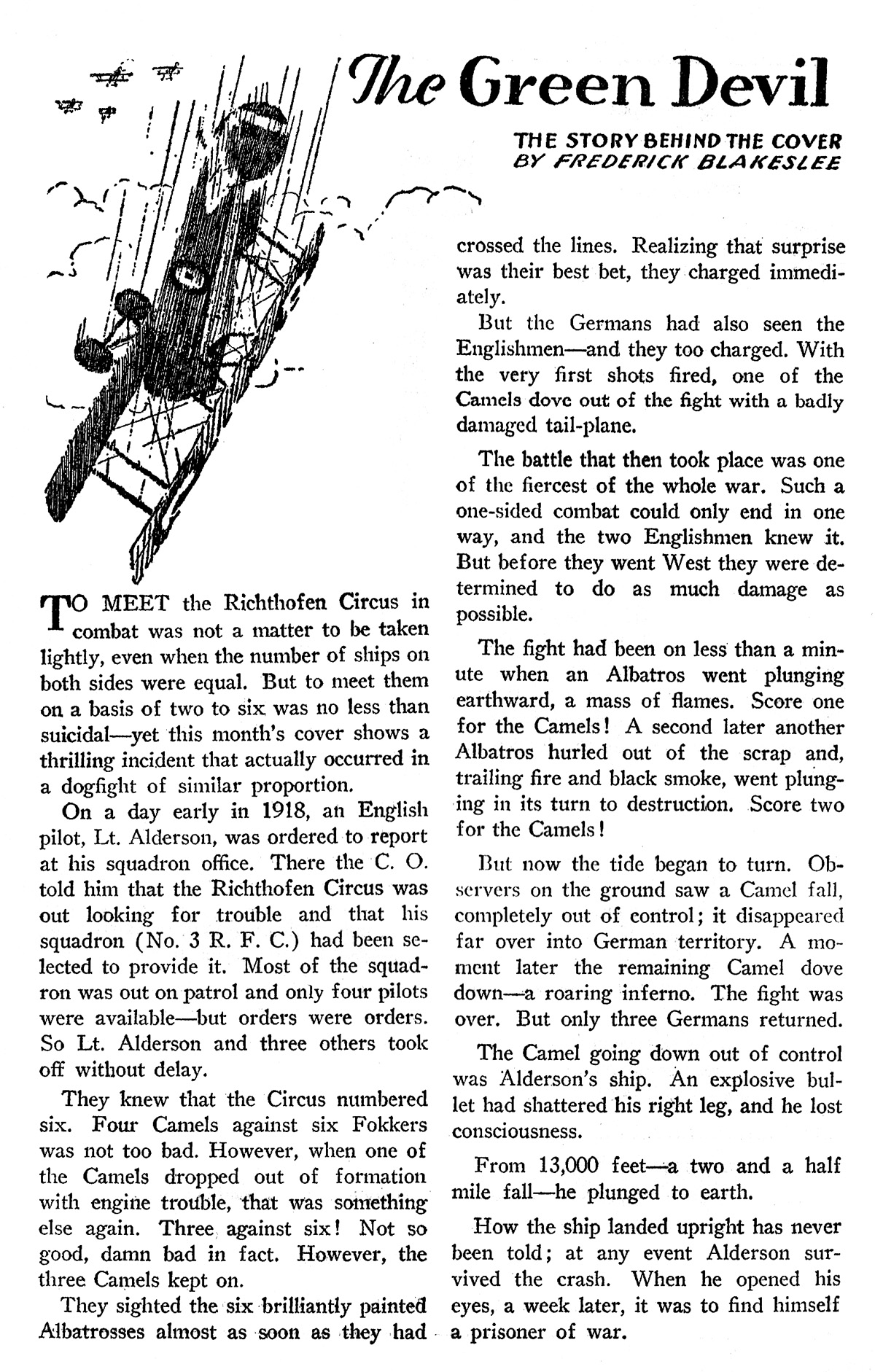How the War Crates Flew: Night Flying
FROM the pages of the January 1934 number of Sky Fighters:
Editor’s Note: We feel that this 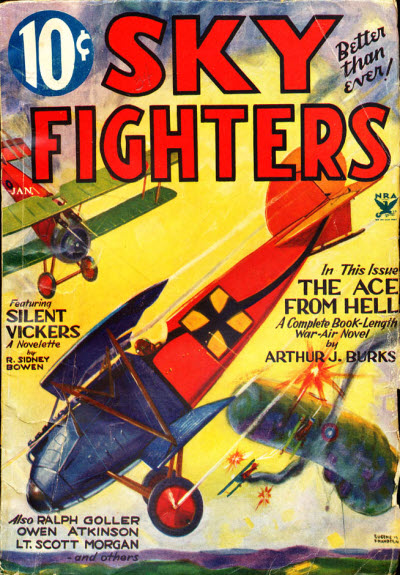 magazine has been exceedingly fortunate in securing R. Sidney Bowen to conduct a technical department each month. It is Mr. Bowen’s idea to tell us the underlying principles and facts concerning expressions and ideas of air-war terminology. Each month he will enlarge upon some particular statement in the stories of this magazine. Mr. Bowen is qualified for this work, not only because he was a war pilot of the Royal Air Force, but also because he has been the editor of one of the foremost technical journals of aviation.
magazine has been exceedingly fortunate in securing R. Sidney Bowen to conduct a technical department each month. It is Mr. Bowen’s idea to tell us the underlying principles and facts concerning expressions and ideas of air-war terminology. Each month he will enlarge upon some particular statement in the stories of this magazine. Mr. Bowen is qualified for this work, not only because he was a war pilot of the Royal Air Force, but also because he has been the editor of one of the foremost technical journals of aviation.
Night Flying
by Robert Sidney Bowen (Sky Fighters, January 1934)
WELL, I note that both of you sparrows are here again. And I suppose that means I’ve got to do some talking and improve your knowledge as to the activities of myself, and other world renowned heroes, during the late unpleasantness.
This time I’ll gabfest on the advantages, disadvantages, and ups and downs of night flying in the days when girls used to marry uniforms.
A Mean Job
To begin with, let me say that next to daylight bomb raids, night flying was about the meanest and toughest job that the C.O. could pass out to you. You seldom saw what you were banging away at, and the other guy wasn’t any better off.
How-the-some-ever, night flying was not originated with the idea of giving pursuit pilots something else to do. As a matter of fact, pursuit ships didn’t begin to take much part in night flying work until along about the last year of the war.
Generally speaking, night flying, simply meant bombing raids at night. Long range assignments with destinations far behind the enemy lines.
The Germans Started It
To get at the idea from a historical viewpoint, night flying in the world war was really first started by the Germans. How, you ask? With their Zeppelins, stupid. Why certainly! The Zeppelin raids on London and Paris were made under cover of darkness.
The reason for that is, of course, quite obvious. A Zeppelin raid in the daytime would be just too bad for the Zeppelin. It would be spotted long before it reached its objective.
No, Alice, this is not going to be a discourse on Zeppelin raids. So tuck in your bib and pay attention.
I spoke of Zeppelins being first used in night flying work to point out the fact that night flying was fundamentally an offensive maneuver.
How come?
Home Defense Squadrons
VERY well, let me explain the difference. In the daylight your air force raids enemy territory, repels enemy raids into your territory, and also reconnoiters enemy territory. In short there is a definite object for every patrol. But at night there were no scheduled patrols for planes on the receiving end. And by the receiving end, I mean territory that was being raided. To make it a bit more clear than that, flights of ships whose job it was to repel night invaders or raiders, didn’t take to the air until the raiders made the first move. Such squadrons were known as Home Defense Squadrons. And that’s just what they did—defended the fireside against invaders. In other words, in the daytime you flew patrols whether the enemy was there or not. But at night you only flew when the enemy came to call.
Rather than frighten the French and English populace, Zeppelin warfare made them all the more determined to defeat Germany.
Not favoring the construction of Zeppelins, or I should say, lighter-than-air-aircraft, the Allies started to hit back with long range bombing raids (Fig. 1) on German strongholds behind the lines. Most of these raids were conducted by the English, and to them should go everlasting praise for their accomplishments.
Not tor the Chicken-Hearted
A bomb raid at night is not a job for chicken-hearted men. To begin with, you’ve got to have a clear night to see things on the ground. Nowadays with blind flying developed as it is, with airway beacons, and all the rest of it, a pilot can fly from here to there and back again in almost any old kind of weather. But in war days a clear night was very essential.
But as even you two nitwits can see, what was a break for the raiders was also a break for the defenders. In other words, if you could see them, they could also see you.
There were no special hours of the night for bomb raids. The time of take-off really depended upon how far you had to fly before you could let the old “eggs†go whanging down. But the dangers of night bombing raids began just as soon as you opened up the throttle.
Today when a ship takes off at night, the runway is bathed in flood lights, and it’s just about as easy as a daytime take-off. But in war days, you did the best you could and trusted to luck for the rest. There were no flood lights, or any of the other fancy gadgets that you have today. The “runway†was simply the best part of your drome, and it was lighted by parallel rows of oil pots (Fig. 2). The ship simply took off between the two rows.
What They Looked Like
And speaking of oil pots, next time you’re out driving with the girl friend at night (you do, don’t you?) and you come to a spot where they’re digging up the road, take a look at those ball-like things that rim the ditch. They look like a bomb full of oil, and burning at the top. Well, those things are what oil pot flares used to look like during the war.
WELL, as soon as you’ve taken off, the oil pots are doused, because it’s not any help to advertise the location of your drome to any enemy ships that might be upstairs. And after those oil pots go out, the rest is up to you. If there is more than one ship in the raid, each pilot has got to make sure he doesn’t ram into the other guy. To avoid that they usually flew in follow-the-leader-style. Not only did that permit the pilot to see the exhaust flames of the ship ahead, and thus keep his distance, but it also permitted more effective bombing of the objective. When the objective was reached the first plane would drop its bombs and then bank wide and swing for home. The second ship would do the same thing, and after it, the third ship, and so on.
Naturally, while you are heading for your objective the enemy hears you, and he tries to spot you with his searchlights. And when he does, look out, because you’re going to get a shower bath of archie in the next few seconds. When one searchlight gets you, two or three others swing right over with the idea of “boxing†you—fixing you so’s you can’t dodge either way into the darkness, and escape. At such times, good piloting counts plenty, and how.
Of course, most of the time defending ships don’t wait for searchlights to nail you. They come streaking up, using your exhaust flames as a guide to where you are. And in turn your gunners use their exhaust flames as a guide to where the attacking pursuits are.
The Return Trip
Once you’ve let your eggs go, you can bet your shirt that the enemy is going to try his damnedest to get you. And so the return trip is really worse than the journey out. Besides, you’ve got to get the ship down okay.
When the home drome mechanics hear you, they set out landing marks on the drome. These are oil pots set out in a way that will indicate the direction of the ground wind. There were two signs generally used. One was in the shape of a big L, (Fig. 3) the bottom of the L being at the leeward side of the drome. In other words, you landed along the upright part of the L, toward the bottom piece. The idea being that the area formed by the angle was the smoothest part of the field.’
The other sign were lights in the form of a T, (Fig. 4) with the crosspiece being toward the leeward side of the field. And so you simply landed along either side of the leg of the T, toward the cross piece.
Sounds simple, doesn’t it? Well don’t kid yourself, sweetheart. Those oil pots never did blind you with their light, and it took wonderful pilots (like me) to get down without jarring the other guy’s teeth.
Night Pursuit Flying
To get the idea of pursuit flying at night, just reverse what I’ve been telling you about a night bombing raid. The night pursuit ships (or, bats, as your favorite authors like to call them) simply took the air when enemy bombers were announced. Their job consisted of two things. One, to get the bombers.
And the other, to avoid smacking into one of their own men. I never could decide just which job gave me the most gray hair.
Just one more thing, and I’m gone. It’s about sighting landmarks at night. One tough job, children, unless there’s a moon. About the only thing you can really see clearly, is water—rivers, lakes, etc. The rest you guess at. And here’s an interesting item lots of folks don’t know. It was a cinch for German Zeppelins to find either London or Paris at night. Why? Because both cities are on a river, and their metropolitan areas are exactly between two islands in each river, both the Thames and the Seine. They simply hovered over either of those areas and let go. And speaking of “go,†that means me. too! Good evening.









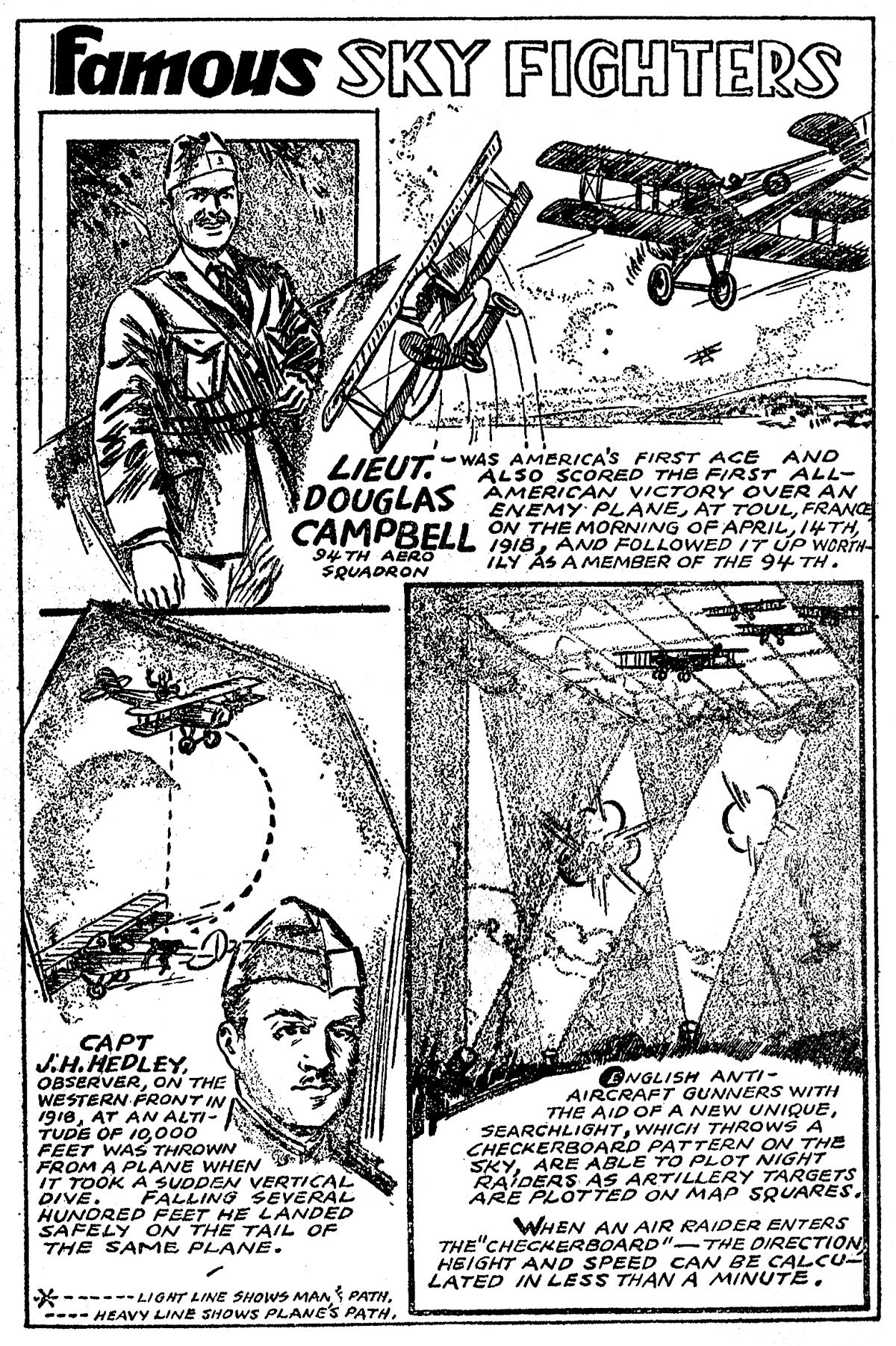
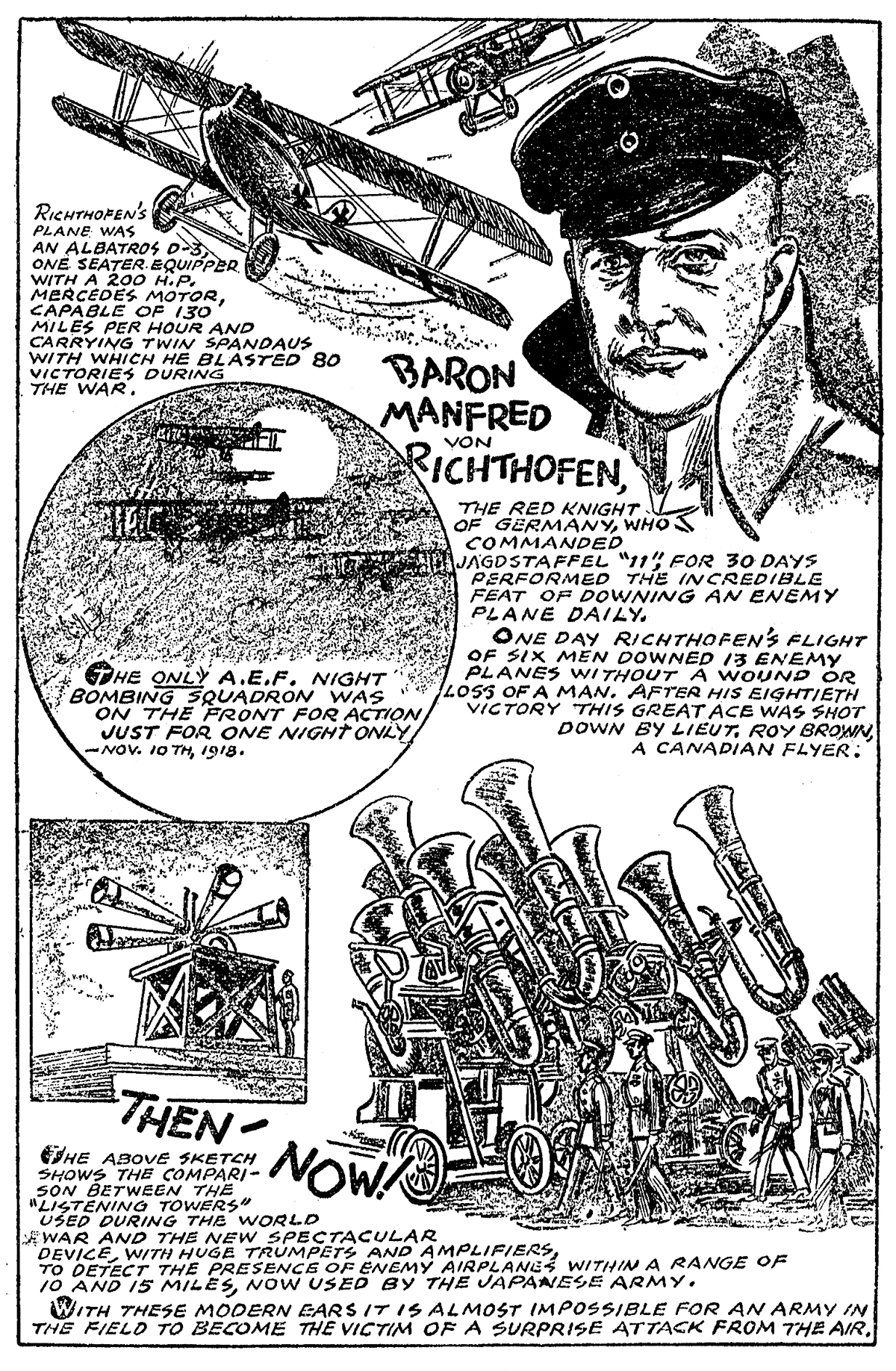
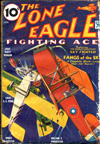
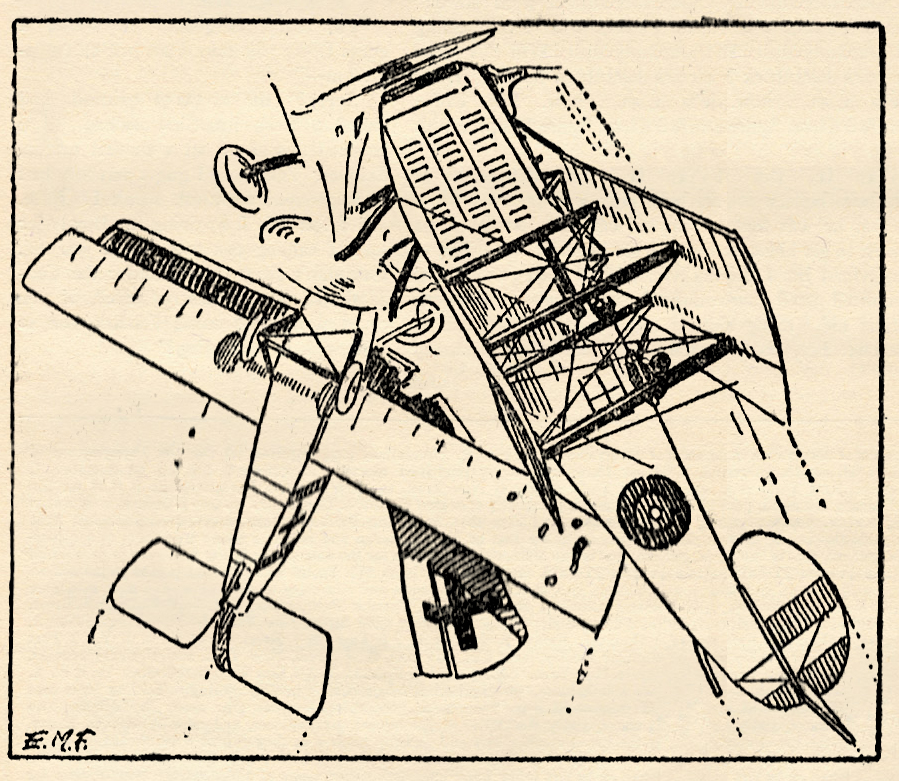
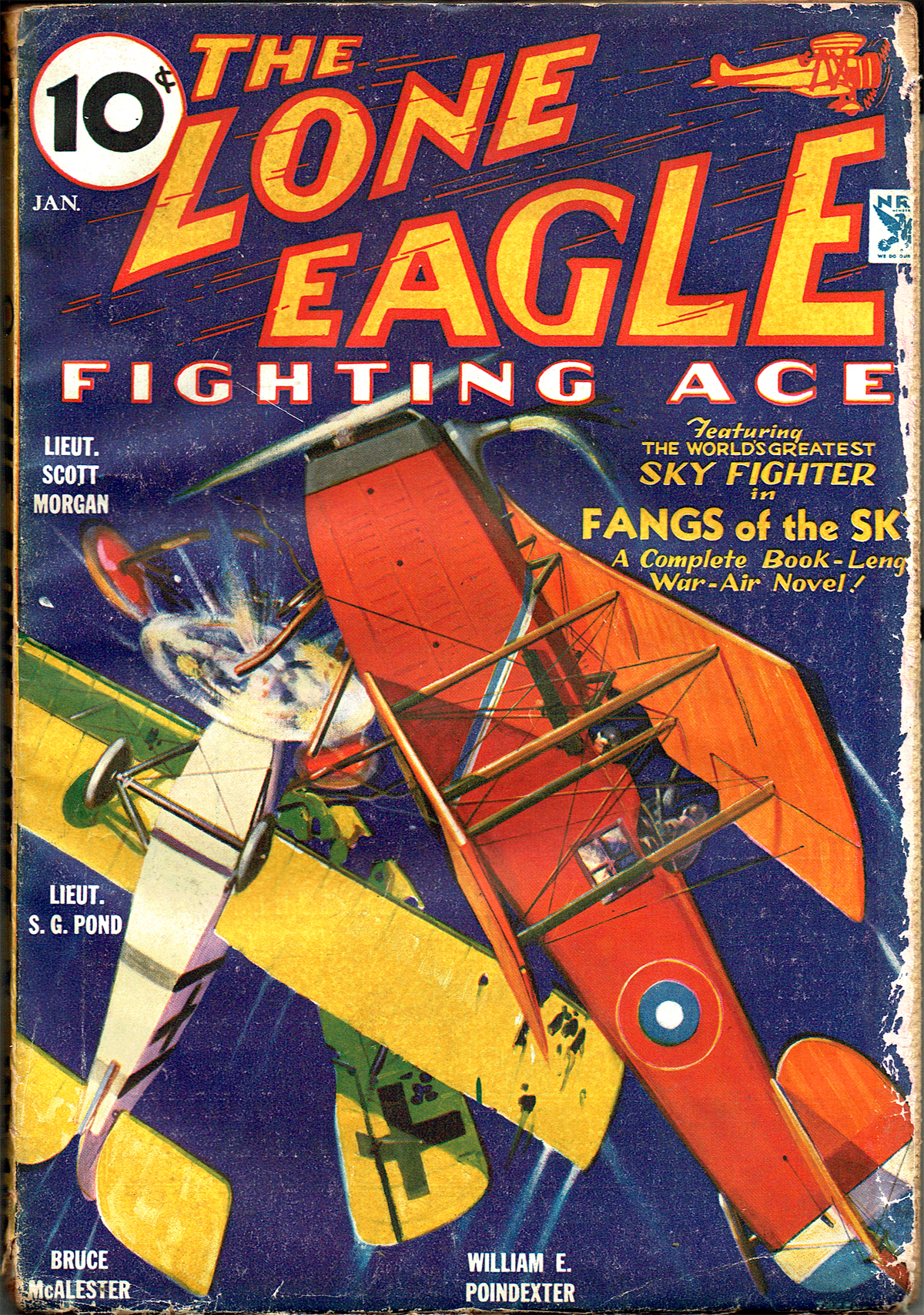
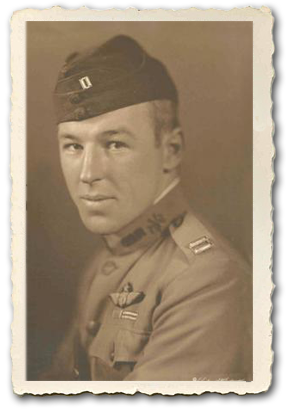
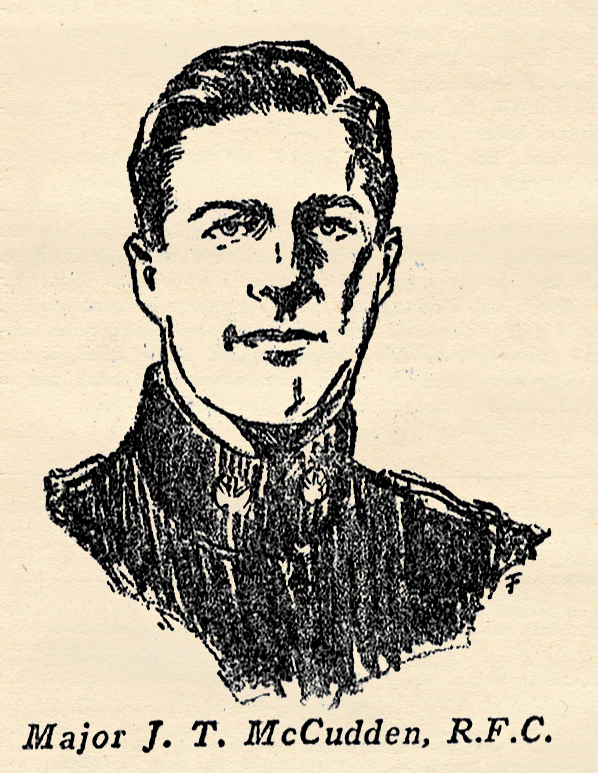 one of the most modest and unassuming of the great flying aces. When the war began he was an engine mechanic with the then recently formed Royal Flying Corps. After flying training he became a Sergeant pilot, and began, piling up the string of victories which eventually placed him at the top of all the British aces. He was progressively promoted to Lieutenant, Captain and Major, and won every medal possible, including the Victoria Cross.
one of the most modest and unassuming of the great flying aces. When the war began he was an engine mechanic with the then recently formed Royal Flying Corps. After flying training he became a Sergeant pilot, and began, piling up the string of victories which eventually placed him at the top of all the British aces. He was progressively promoted to Lieutenant, Captain and Major, and won every medal possible, including the Victoria Cross.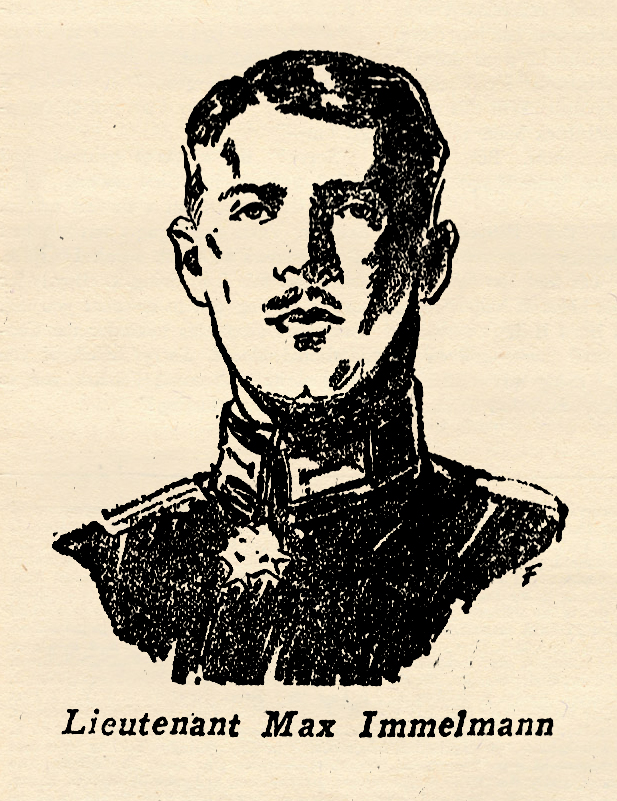 Immelmann was the first of the great German Aces. Immelmann scored victory after victory over the Allied flyers until his total score mounted higher than that of any of the Allied Aces.
Immelmann was the first of the great German Aces. Immelmann scored victory after victory over the Allied flyers until his total score mounted higher than that of any of the Allied Aces.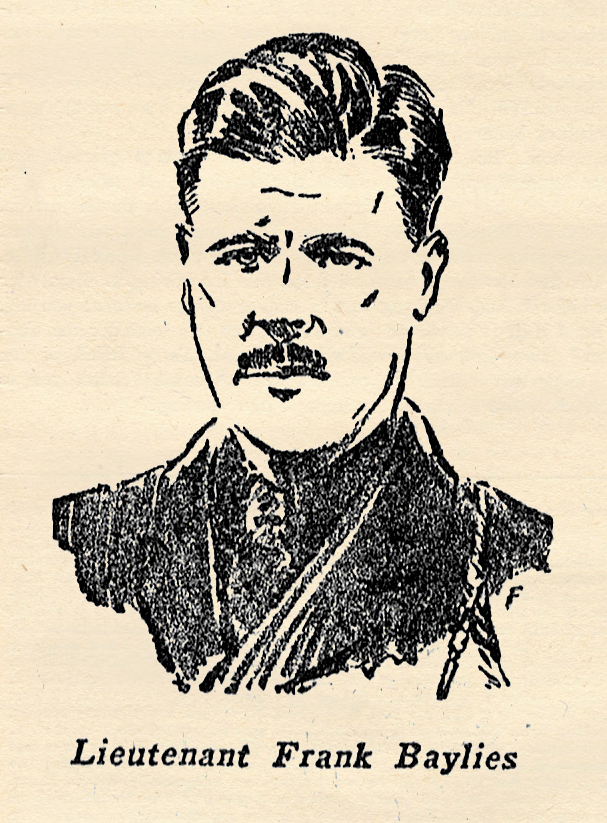 American Ambulance section, serving in that unit attached to the French armies from February 26th, 1916, to May 11th, 1918. In the early spring of ‘18 he transferred to the aviation. He became a member of the famous Stork squadron of the French Flying Corps.
American Ambulance section, serving in that unit attached to the French armies from February 26th, 1916, to May 11th, 1918. In the early spring of ‘18 he transferred to the aviation. He became a member of the famous Stork squadron of the French Flying Corps.